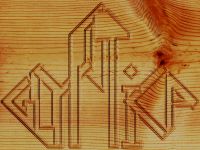
To answer your first question:
We (Lenna Mahoney and Bill Statler) established Glyptica in our basement in 1995 with some computer-controlled carving equipment from Techno-Isel and a bunch of software custom-written by Lenna.
After a few months of programming plus rebuilding the Techno-Isel
machinery to tolerate the water-cooling we'd need for gemstone-carving, we
finally tested our setup by carving our company logo in a humble pine
board:

Hmm. It looked pretty good. Wood, huh? Cuts fast, needs no water-cooling, looks nice... well, maybe we could delay the stone-carving for just a while, and make some nice things out of wood.
We did so. Result: stunning technological success -- but as a business venture, hopelessly demanding of time (human and machine) for the value of the items produced.
How does all this work anyway? Do we just push a button, and out pops a finished work of art?
Well, not quite. Someone has to design the item, for starters. (That's usually Lenna's job.) The original design might start as a pencil sketch which then gets scanned into the computer, translated into vector graphics, and cleaned up using draw software. Or, we might start with a computer-generated mathematical pattern such as a fractal. In either case, the data describing the pattern are fed into one of Lenna's custom programs, and the output is a series of commands telling the carving machine how to move in three dimensions in order to cut the design into the wood.
Meanwhile, the wood (or whatever material we're using) has to be cut to size and prepared. (Bill usually gets to play with the saws and glue and such.) Once the wood is stained and/or veneered and mounted in the machine, and the corners and top of the wood have all been located to the nearest few thousandths of an inch, and the motion commands are uploaded to the machine's controller, and the right cutting tool is installed, and everyone is wearing safety glasses and ear protectors, and the cat has run for cover... THEN we just push a button, and out pops (after 15 minutes or a few hours or a few days, and assuming everything works right) a not-quite-finished work of art. (There still remains the hand-cleanup of "fuzz" left by the carving machine, and the application of finish, and the mounting of gemstones, and other little things like that.)
Below are some of our finished woodcarvings. Click on one of the small images for a larger picture:
 Bast
Bast
The ancient Egyptian goddess Bast was usually represented as a cat-headed
woman. Here, we've carved her onto a plaque of Honduras mahogany.
 Nefertiti
Nefertiti
A profile of the Egyptian queen, Nefertiti, carved in African Padauk with
Eucalyptus veneer.
(Artwork on Bast and Nefertiti by Lenna Mahoney, based on several Egyptian originals.)
 Mandelbrot fractal
Mandelbrot fractal
The Mandelbrot equation is (x + yi)2 in the
complex region x = -2.25 to 1.25, y = -1.25 to 1.25.
(There will be an exam on this next week.) Here, two Mandelbrot images
have been distorted and superimposed.
This design started as a mathematical expression which was computer-rendered as a grayscale image. We carved the image into the Honduras mahogany plaque as a shallow bas-relief. Lenna's custom software adjusted the cutting depth to match the darkness of each pixel in the original image. After carving we added some cobalt-blue stain to highlight the pattern.
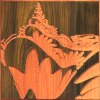 Biomorph fractal
Biomorph fractal
Clifford A Pickover invented "biomorph fractals" by entering a typo into a
computer program. We added another typo and came up with this variant. The
image was carved onto a beech wood plaque, the surface of which had
previously been darkened with graphite and green stain.
If you want to reproduce this pattern with your own fractal software, read A K Dewdney's "Computer Recreations" column, Scientific American, July 1989, page 110. This pattern uses the formula [ex+yi + sin(x + yi) + x+y2] in the complex region x = -7.2 to -4.8, y = -2.87 to -0.47.
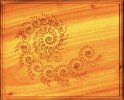 "Crop
Spiral" fractal
"Crop
Spiral" fractal
A fractal curve such as this is generated by recursion of a "seed" line
pattern. Each part of the seed is replaced by a small version of the
whole. Then each part of that is replaced... ad quasi infinitum.
Nearly any simple line pattern can be used as the seed of a fractal... hence, the following designs based on characters of the runic alphabet, and rendered in basswood with red gum veneer and semiprecious stones:
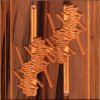 HAGALL fractal, based on
the rune
HAGALL fractal, based on
the rune 
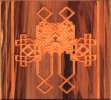 OTHEL
fractal, based on the rune
OTHEL
fractal, based on the rune 
 TYR
fractal, based on the rune
TYR
fractal, based on the rune 
 EOLH
fractal, based on the rune
EOLH
fractal, based on the rune 
 Curse
of the Mushroom People
Curse
of the Mushroom People
Shrooms do have their dark side.